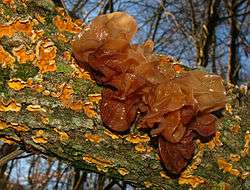Tremella foliacea
| Tremella foliacea | |
|---|---|
 | |
| Tremella foliacea and its host, Stereum hirsutum | |
| Scientific classification | |
| Kingdom: | Fungi |
| Division: | Basidiomycota |
| Subdivision: | Agaricomycotina |
| Class: | Tremellomycetes |
| Order: | Tremellales |
| Family: | Tremellaceae |
| Genus: | Tremella |
| Species: | T. foliacea |
| Binomial name | |
| Tremella foliacea Pers. (1800) | |
| Synonyms | |
|
Tremella fimbriata Pers. (1800) | |
Tremella foliacea is a species of fungus producing brownish, frondose, gelatinous basidiocarps (fruit bodies). It is widespread, particularly in north temperate regions, and is parasitic on other species of fungi (Stereum spp.), that grow on dead attached and recently fallen branches of broadleaf trees and conifers. Common names include leafy brain,[1] jelly leaf, and brown witch's butter. The species is said to be edible, but is not much valued.[2]
Taxonomy
Tremella foliacea was first published in 1800 by South African-born mycologist Christiaan Hendrik Persoon. He simultaneously published a second species, Tremella fimbriata, said to be distinguished by its more undulating and incised fronds. The two species have long been considered synonyms, with T. foliacea the preferred name.[3]
The epithet "foliacea" means "leafy", with reference to the shape of the fruit bodies.
Description
Fruit bodies are gelatinous, pale to dark brown, sometimes purple-brown to almost black, up to 20 cm (8 in) across, and seaweed-like (with branched, undulating fronds). Microscopically, the hyphae are clamped and occur in a dense gelatinous matrix. Haustorial cells arise on the hyphae, producing filaments that attach to and penetrate the hyphae of the host. The basidia are tremelloid (globose to ellipsoid, with oblique to vertical septa), 10 to 19 by 8 to 14 μm, usually unstalked. The basidiospores are mostly ellipsoid, smooth, 6.5 to 10 by 4.5 to 8 μm, and germinate by hyphal tube or by yeast cells.[4][5]
Similar species
Tremella foliacea is variable and may represent a complex of similar species across its range.[5] Chen (1998) described three new species in the "foliacea" group, based on microscopic differences and on DNA sequencing: Tremella vasifera from Germany and T. fuscosuccinea and T. neofoliacea from Taiwan.[5] Tremella coffeicolor (synonym T. auricularia), originally described from Bermuda, is similar, but has larger basidia and spores. It is also known from the Azores, the Caribbean islands, and South America.[6]
Habitat and distribution
Tremella foliacea is a parasite of Stereum species (including S. rugosum, S. hirsutum and S. sanguinolentum), growing on the host's hyphae in the wood rather than on the host's fruit bodies. Following its hosts, fruit bodies of T. foliacea are typically found on dead, attached or recently fallen branches of broadleaf trees and conifers.[4]
The species has a cosmopolitan distribution and is known from North & South America, Europe, northern Asia, north Africa, Australia, and New Zealand.[5]
External links
| Wikispecies has information related to: Tremella foliacea |
| Wikimedia Commons has media related to Tremella foliacea. |
- Tremella foliacea in MycoBank.
- California Fungi – photo and description
- Mushroom Expert – photos and description
References
- ↑ "Recommended English Names for Fungi in the UK" (PDF). British Mycological Society.
- ↑ Arora, David (1986). Mushrooms demystified: a comprehensive guide to the fleshy fungi (2nd ed.). Berkeley: Ten Speed Press. ISBN 0-89815-169-4.
- ↑ Donk MA. (1966). "Check list of European hymenomycetous heterobasidiae". Persoonia. 4: 145–335.
- 1 2 Roberts P. (1999). "British Tremella species II: T. encephala, T. steidleri & T. foliacea". Mycologist. 13 (3): 127–131. doi:10.1016/S0269-915X(99)80044-5.
- 1 2 3 4 Chen C-J. (1998). Morphological and molecular studies in the genus Tremella. Berlin: J. Cramer. p. 225. ISBN 3-443-59076-4.
- ↑ Roberts PJ, Spooner BM. (2004). "Heterobasidiomycetes from the Azores". Kew Bulletin. 59: 95–101. doi:10.2307/4111079.
